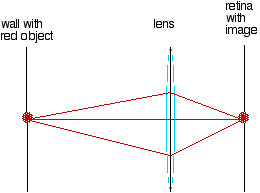
Three red ray of light diverge from a red dot on a wall and are brought together by the lens of the eye creating an image on the retina.
Explanation of the Motion of Laser Speckle
The lens of the eye looks at a red dot on a wall.
The lens of the eye makes an image of the red dot on the retina.
Many rays of light spread out from the red dot all the rays that pass through the lens of the eye are brought together to form an image on the retina.

The wall is also broadly illuminated by green laser light that appears to have dark speckles.
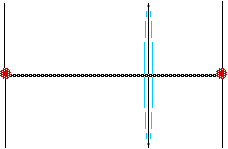
Laser lightwaves scattered from the wall interfere with each other and create a dark line in space. This line appears as a dark spot when it intersects the retina.
(I chose the dark line that goes right through the center of the lens, this is an easy choice to create and to understand.)
These speckles are due to the interference of laser light scattered by the rough wall. The interference pattern creates dark (and light) rays coming out from the wall. These rays are narrow beams which are perceived by the retina. They are rays so they are always in focus, no matter what the focal length of the lens is. If the eye moves up the ray no longer hits the same spot on the retina so the place where there is a dark spot on the wall becomes a bright spot.
That is why I say:
"There are no dark spots on the wall!"
There are dark cylinders which intersect the retina creating a dark spot on the retina which the eye-brain interprets as coming from a dark spot on the wall.
Now move the eye up.
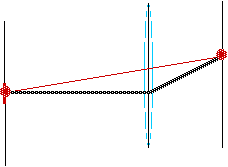
The red light spreads from a point on the wall and forms an image on the retina. The light that travels through the center of the lens is called the chief ray and goes in a straight line. Where it strikes the retina is the location of the image. The dark beam of laser interference hits the lens no longer at the center and so is bent upward. It arrives at the same spot on the retina as the image of the dot. So a viewer sees no motion of the laser speckle dark spots relative to the wall.
Nearsighted eye
Eyes focus by maximizing contrast in an image. An out of focus image is fuzzy with soft contrast, an in focus image has sharp edges and strong contrast. However because the laser speckle is made of beams of light and dark it maintains sharp contrast regardless of where the eye is focussed. So the eye gets no clues about where to focus when looking at a laser speckle pattern. A near-sighted eye will then tend to focus images in front of the retina.
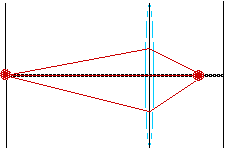
The light from the red dot on the wall spreads out, strikes the lens of the eye, and is brought together to form an image in front of the retina. This is shown by the red lines in the above image. The black band show laser speckle passing through the center of the lens.
Now move the near sighted eye up.
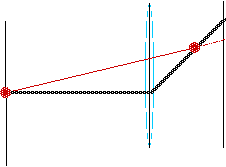
When a nearsighted eye moves up the dark beam from laser speckle moves across the retina relative to the motion of the image of the red dot.
Notice that the location of the laser speckle beam moves up on the retinal further than the motion of the image of the red spot on the wall. Since the brain/retina inverts images, this extra upward motion on the retina is perceived as a downward motion relative to the dot.
Far-sighted eye
Well, you really should do this figure yourself to see if you understand what is going on.
The far sighted eye makes an image behind the retina.
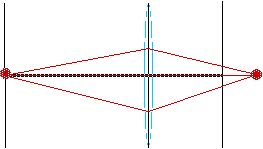
The light from a red spot on a wall is brought together as an image behind the retina.
The dark beam from the laser speckle goes through the center of the lens and strikes the retina at the same position as the location of the image of the spot.
Now when the far-sighted eye moves up.
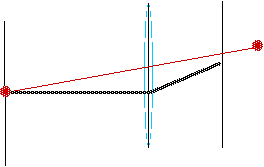
When the far-sighted eye moves up, the Chief Ray through the center of the lens shows the location of the red dot on the retina.
The dark beam from the laser speckle strikes the retina below the location of the image of the red dot.
Once again, since the brain/retina inverts the image, the downward motion of the laser speckle dot on the retina relative to the red dot reference is upward. The viewer perceives the laser speckle moving upward when the viewer moves upward.
|
Scientific Explorations with Paul Doherty |
|
27 June 2006 |